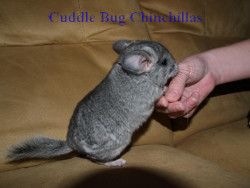Even though each chinchilla is an individual, the majority do share some general behaviors. People who spend time with their chinchillas will discover that these amazing little animals are quite intelligent and perceptive. By being observant and using what abilities they have, chinchillas can learn routines, ask for attention, express affection, happiness, or delight, communicate a desire to mate, ask to be put down or left alone, and show fear or anger.
When a chinchilla owner repeatedly performs the same task; cleaning the cage, feeding the chinchilla, giving treats, and supplying playtime, the chinchilla will learn a routine and expect these things at their usual times. Additionally, certain sounds, such as the rustling of the food bag or opening a container, and footsteps are signals to the chinchilla that something is going to happen and they will respond accordingly.
If the owner is late in supplying something, or if it wants attention, the chinchilla will stand on its hind legs in an area of the cage that is close to the owner to get attention. If this tactic does not work, the chinchilla may begin barking, biting or rattling the cage bars, or even climbing the walls of the cage to get what they want.
A happy chinchilla can also communicate its mood through behaviors such as smiling, winking, wall surfing, pop corning and tail wagging. Winking usually occurs when the chinchilla is content or acknowledging a communication from its owner. Wall surfing consists of running around, jumping up and bouncing off the walls. Pop corning is a jump, straight up in the air, usually accompanied by a twitch or jerk at the top of the jump. Both these behaviors are displayed by very happy and excited chinchillas. Another behavior of a happy chinchilla is displayed by the males. When they get the scent of a female or are in the same cage with a female that is in season, they will wag their tails at the female. This is often referred to as the swishy tail dance and is quite adorable. The tail will move from side to side, curling and uncurling as it does so.
When a chinchilla would like to be put down because they need to urinate, eat, want to play, or have had enough of being held for the moment, they may nibble on their owner’s hand. This is not the same as a bite. Nibbling is a way of communicating and showing affection. Another type of nibbling that a chinchilla will do is grooming. Chinchilla grooming consists of a series of light nibbles and is done as a sign of affection.
Chinchillas can also tell their owner to leave them alone. If they do not wish to be picked up, they will often push against the owner’s had with their front paws. Ignoring this behavior can have unpleasant consequences. Annoyed or angry chinchillas may release their scent gland. It is located in the chinchilla’s anus. The scent released by this gland smells like burnt almonds or vitamins. Additionally, females can spray urine when they are angry or scared. This behavior is usually preceded by standing up on their rear legs and scooting in this position.
Frightened chinchillas often display a head or whole body shake. The shaking is usually quite mild and should not be confused with a seizure. When chinchillas shake, the owner should talk quietly and calmly to reassure them. Chinchillas can also show their disapproval with a person. This is done by swiping the nose with one front paw while looking straight at the owner. It is quite comical to see and there is no mistaking the intent.
Lastly, blowing in a chinchilla’s face is something that should be avoided. Blowing on them can cause the chinchilla’s instincts to react as if they are being bombarded by another animal’s defence mechanisms. Even if they do not panic, it usually has the affect of making the chinchilla angry.
 attempt-writing
attempt-writing

- Home
- Information
- Shows
- Show Results
- Upcoming Shows-outdated
- Information on Showing
- Rescue
- Chinchillas
- Adults
- Babies
- Rescues
- Purchasing
- Supplies
- Boarding
- Contact Us
Fall Sale
Extended to November 16th

Understanding Your Chinchillas Behavior



 Site Last Updated on December 31, 1969 05:00 pm
Site Last Updated on December 31, 1969 05:00 pm
